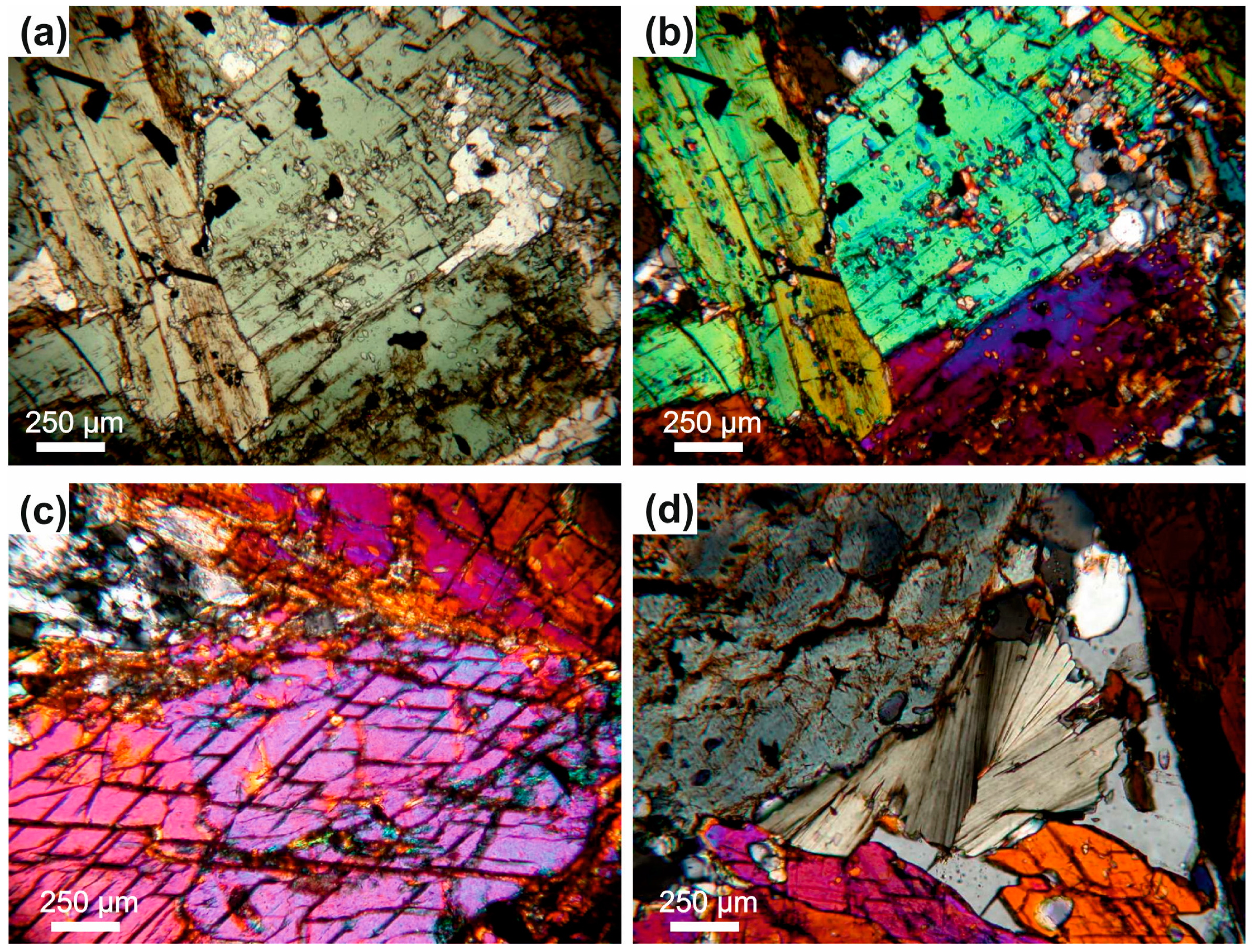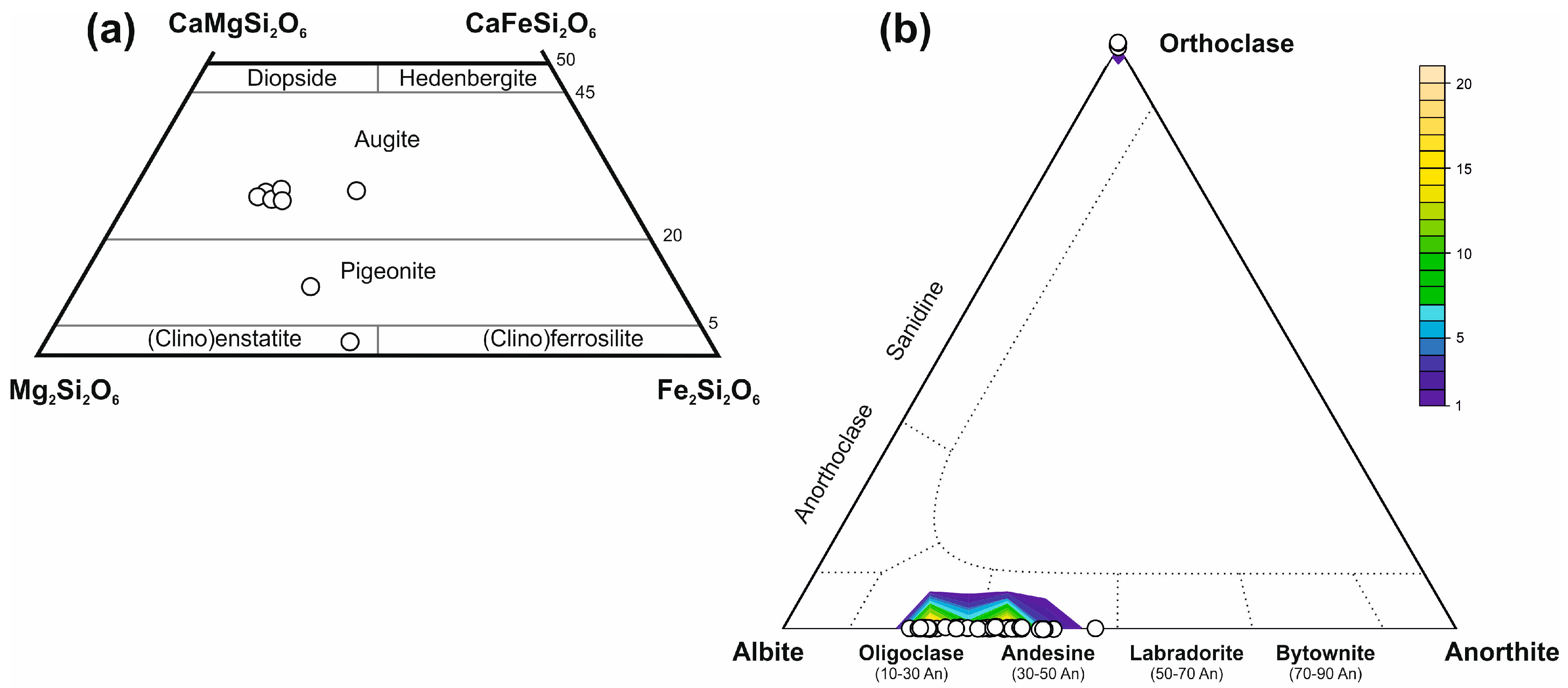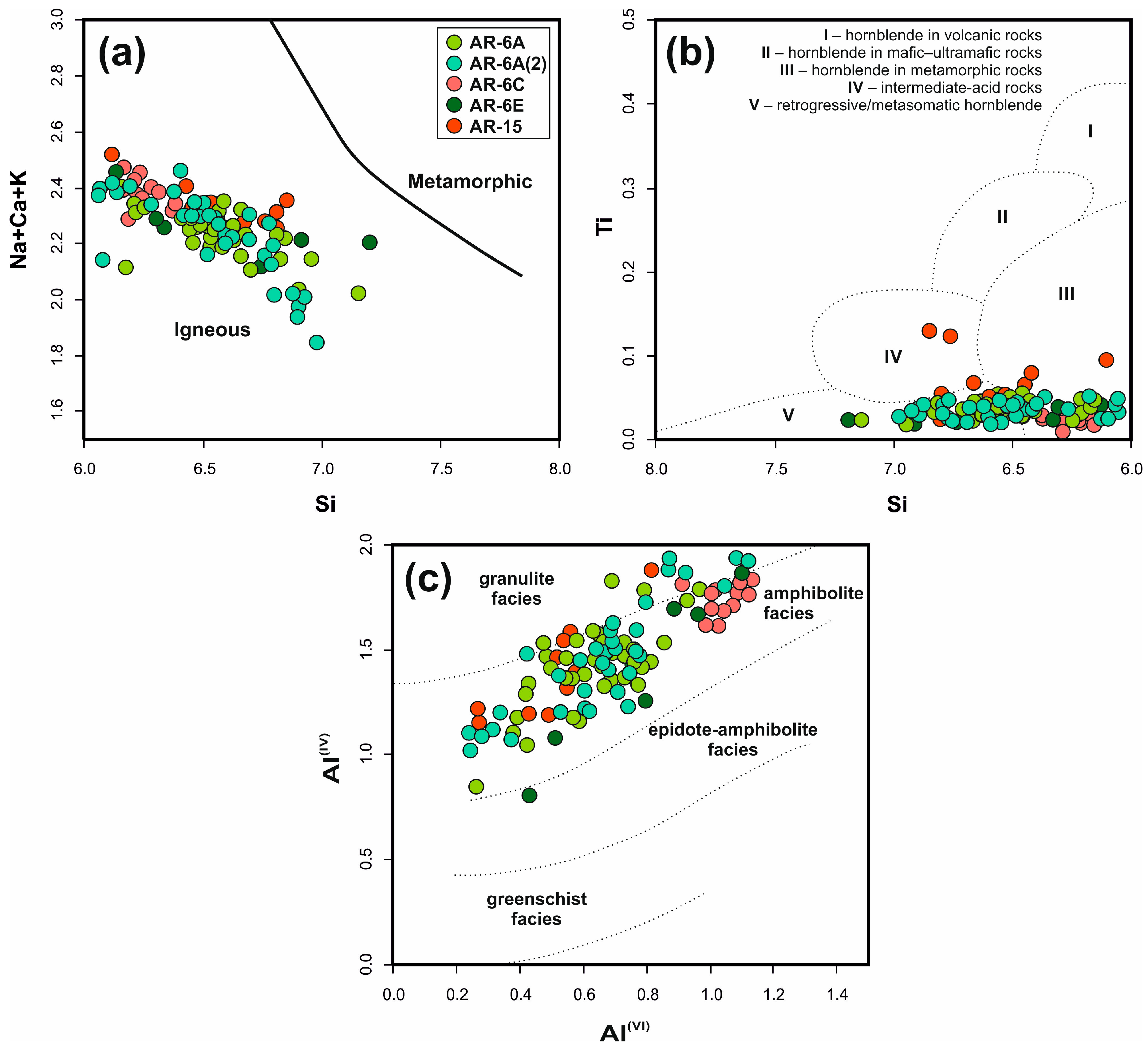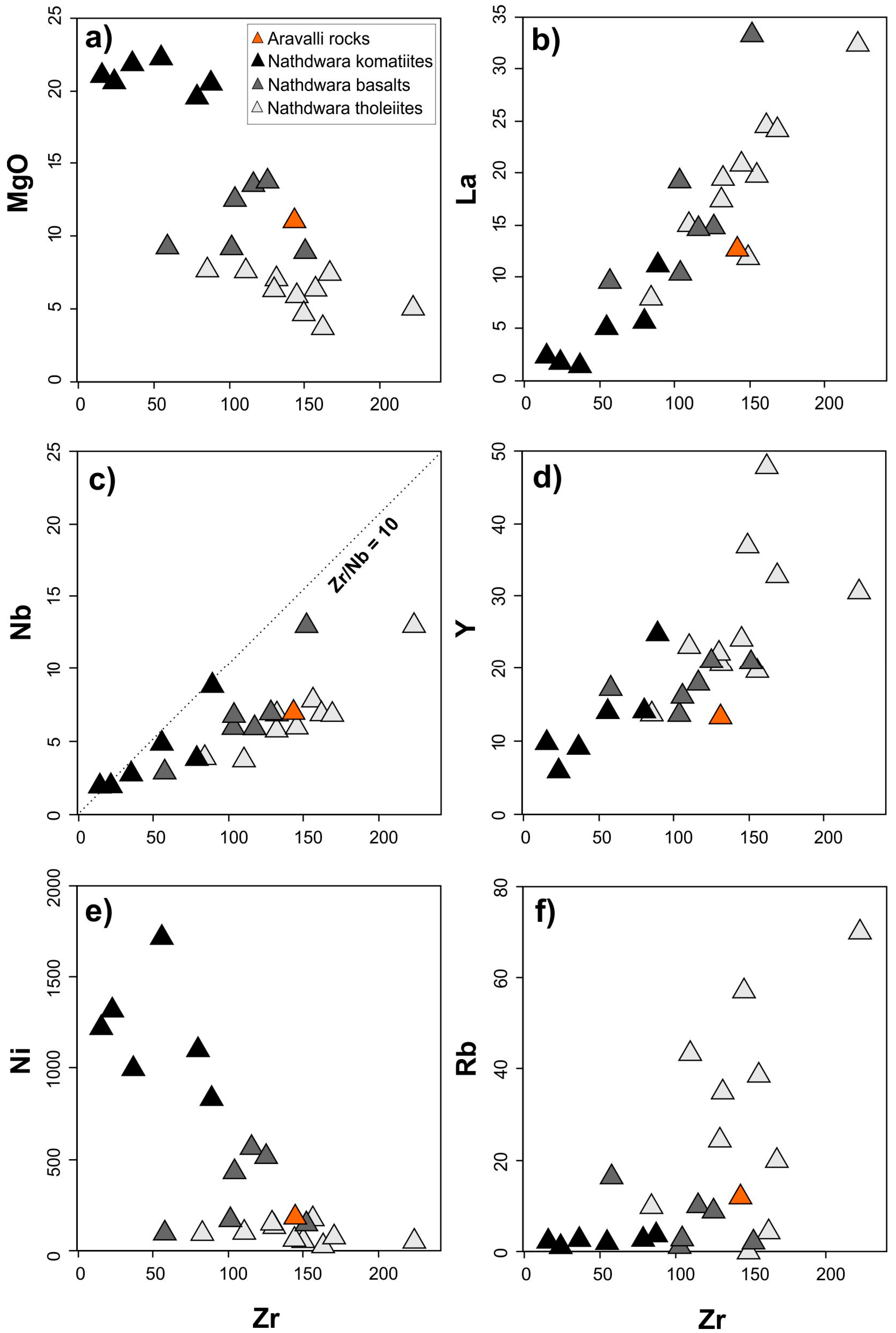Contribution to the Mineral Chemistry of the Proterozoic Aravalli Mafic Meta-Volcanic Rocks from Rajasthan, NW India
Abstract
:1. Introduction
2. Materials and Methods
3. Results
3.1. Field Occurrence
3.2. Mineral Chemistry of the Suspect Pillow Lava
3.2.1. Amphibole
3.2.2. Pyroxene
3.2.3. Feldspar
3.2.4. Chlorite
3.2.5. Ilmenite
3.3. Geothermo-Barometers
3.4. Geochemistry of Aravalli Pillow Lava
4. Discussion
Supplementary Materials
Author Contributions
Funding
Acknowledgments
Conflicts of Interest
References
- De Wit, M.J.; Ashwal, L.D. Greenstone belts: What are they? South. Afr. J. Geol. 1995, 98, 505–520. [Google Scholar]
- Kerrich, R.; Polat, A.; Wyman, D.; Hollings, P. Trace element systematics of Mg to Fe–tholeiitic basalt suites of the Superior Province: Implications for Archean mantle reservoirs and greenstone belt genesis. Lithos 1999, 46, 163–187. [Google Scholar] [CrossRef]
- Polat, A. Growth of Archean continental crust in oceanic island arcs. Geology 2012, 40, 383–384. [Google Scholar] [CrossRef]
- Condie, K.C. TTG and adakites: Are they both slab melts? Lithos 2005, 80, 33–44. [Google Scholar] [CrossRef]
- Condie, K.C.; Kröner, A. The building blocks of continental crust: Evidence for a major change in the tectonic setting of continental growth at the end of the Archean. Gondwana Res. 2013, 23, 394–402. [Google Scholar] [CrossRef]
- Tewari, H.C.; Prasad, B.R.; Kumar, P. Structure and Tectonics of the Indian Continental Crust and Its Adjoining Region: Deep Seismic Studies, 1st ed.; Elsevier: Amsterdam, The Netherlands, 2008; pp. 57–72. [Google Scholar]
- Fareeduddin; Banerjee, D.M. Aravalli craton and its mobile belts: An update. Episodes 2020, 43, 88–108. [Google Scholar] [CrossRef] [Green Version]
- Ahmad, T.; Rajamani, V. Geochemistry and petrogenesis of the basal Aravalli Volcanics near Nathdwara, Rajasthan, India. Precambrian Res. 1991, 49, 185–204. [Google Scholar] [CrossRef]
- Malviya, V.P.; Arima, M.; Pati, J.K.; Kaneko, Y. Petrology and Geochemistry of metamorphosed basaltic pillow lava and basaltic komatiite in the Mauranipur area: Subduction related volcanism in the Archean Buldenkhand Craton, central India. J. Miner. Petrol. Sci. 2006, 102, 191–217. [Google Scholar] [CrossRef] [Green Version]
- Ahmad, T.; Tarney, J. Geochemistry and petrogenesis of Late Archaean Aravalli Volcanics, basement enclaves and granitoids, Rajasthan. Precambrian Res. 1994, 65, 1–23. [Google Scholar] [CrossRef]
- Gopalan, K.; Macdaugall, J.D.; Roy, A.B.; Murali, A.V. Sm-Nd evidence for 3.3 Ga old rock in Rajasthan, north-western India. Precambrian Res. 1990, 48, 287–297. [Google Scholar] [CrossRef]
- Wiedenbeck, M.; Goswami, J.N. An ion-probe single zircon 207Pb/206Pb age from Mewar Gneiss at Jhamarkotra, Rajasthan. Geochim. Cosmochim. Acta 1994, 58, 2135–2141. [Google Scholar] [CrossRef]
- Roy, A.B.; Kröner, A. Single zircon evaporation ages constraining the growth of the Archaean Aravalli craton, northwestern Indian shield. Geol. Mag. 1996, 133, 333–342. [Google Scholar] [CrossRef]
- Roy, A.B.; Kröner, A.; Laul, V. Detrital zircons constraining basement age in a late Archaean greenstone belt of south-eastern Rajasthan, India. Curr. Sci. 2001, 81, 407–410. [Google Scholar]
- Heron, A.M. Geology of Central Rajputana. Geol. Surv. India. Mem. 1953, 79, 389. [Google Scholar]
- Ahmad, T.; Dragusanu, C.; Tanaka, T. Provenance of Proterozoic Basal Aravalli mafic volcanic rocks from Rajasthan, Northwestern India: Nd isotopes evidence for enriched mantle reservoirs. Precambrian Res. 2008, 162, 150–159. [Google Scholar] [CrossRef]
- Ahmad, T.; Deb, M.; Tarney, J.; Raza, M. Proterozoic mafic volcanism in the Aravalli-Delhi Orogen, north-western India: Geochemistry and tectonic framework. J. Geol. Soc. India 2008, 72, 93–111. [Google Scholar]
- Deb, M.; Sarkar, S.C. Proterozoic tectonic evolution and metallogenesis in the Aravalli–Delhi orogenic Complex, Northwestern India. Precambrian Res. 1990, 46, 115–137. [Google Scholar] [CrossRef]
- Naha, K.; Halyburton, R.V. Early Precambrian stratigraphy of central and southern Rajasthan. Precambrian Res. 1974, 1, 55–73. [Google Scholar] [CrossRef]
- Sugden, T.J.; Deb, M.; Windley, B.F. The tectonic setting of mineralisation in the Proterozoic Aravalli Delhi Orogenic belt, NW India. In Developments in Precambrian Geology; Elsevier: Amsterdam, The Netherlands, 1990; Volume 8, pp. 367–390. [Google Scholar] [CrossRef]
- Shore, M.; Fowler, A.D. The origin of spinifex texture in komatiites. Nature 1999, 397, 691–694. [Google Scholar] [CrossRef]
- Bouquain, S.; Arndt, N.T.; Faure, F.; Libourel, G. An experimental study of pyroxene crystallization during rapid cooling in a thermal gradient: Application to komatiites. J. Geophys. Res. Solid Earth 2014, 5, 641–650. [Google Scholar] [CrossRef] [Green Version]
- Hawthorne, F.C.; Oberti, R.; Harlow, G.E.; Maresch, W.V.; Martin, R.F.; Schumacher, J.C.; Welch, M.D. Nomenclature of the amphibole supergroup. Am. Mineral. 2012, 97, 2031–2048. [Google Scholar] [CrossRef]
- Morimoto, N. Nomenclature of pyroxenes. Mineral. J. 1989, 14, 198–221. [Google Scholar] [CrossRef] [Green Version]
- Hey, M.H. A new review of the chlorites. Mineral. Mag. 1954, 30, 277–292. [Google Scholar] [CrossRef]
- Tindle, A.G. Mineral Recalculation Software of Chlorite (Chlorite.xls). Available online: http://www.open.ac.uk/earth-research/tindle/AGTWebPages/AGTSoft.html (accessed on 30 March 2020).
- Cassidy, K.F.; Groves, D.I.; Binns, R.A. Manganoan ilmenite formed during regional metamorphism of Archean mafic and ultramafic rocks from Western Australia. Can. Mineral. 1988, 26, 999–1012. [Google Scholar]
- Blundy, J.D.; Holland, T.J. Calcic amphibole equilibria and a new amphibole-plagioclase geothermometer. Contrib. Mineral. Petr. 1990, 104, 208–224. [Google Scholar] [CrossRef]
- Otten, M.T. The origin of brown hornblende in the Artfjället gabbro and dolerites. Contrib. Mineral. Petr. 1984, 86, 189–199. [Google Scholar] [CrossRef]
- Hammarstrom, J.M.; Zen, E.A. Aluminum in hornblende: An empirical igneous geobarometer. Am. Mineral. 1986, 71, 1297–1313. [Google Scholar]
- Hollister, L.S.; Grissom, G.C.; Peters, E.K.; Stowell, H.H.; Sisson, V.B. Confirmation of the empirical correlation of Al in hornblende with pressure of solidification of calc-alkaline plutons. Am. Mineral. 1987, 72, 231–239. [Google Scholar]
- Mutch, E.J.F.; Blundy, J.D.; Tattich, B.C.; Cooper, F.J.; Brooker, R.A. An experimental study of amphibole stability in low-pressure granitic magmas and a revised Al-in-hornblende geobarometer. Contrib. Mineral. Petr. 2016, 171, 85. [Google Scholar] [CrossRef] [Green Version]
- Krawczynski, M.J.; Grove, T.L.; Behrens, H. Amphibole stability in primitive arc magmas: Effects of temperature, H2O content, and oxygen fugacity. Contrib. Mineral. Petrol. 2012, 164, 317–339. [Google Scholar] [CrossRef]
- Chivas, A.R. Geochemical evidence for magmatic fluids in porphyry copper mineralization. Contrib. Mineral. Petrol. 1982, 78, 389–403. [Google Scholar] [CrossRef]
- Wang, Z.M.; Han, C.M.; Xiao, W.J.; Su, B.X.; Ding, J.X.; Song, S.H. Geochemical and zircon U-Pb and Lu-Hf isotopic constraints on the origin of supracrustal rocks from the mid-Qilian terrane: A comparison between supracrustal rocks on the two sides of the eastern segment of the Altyn Tagh Fault. Precambrian Res. 2017, 294, 284–306. [Google Scholar] [CrossRef]
- Xue, Z.J.; Bai, R.X.; Chen, W. Genetic Mineralogy, 1st ed.; University of Geosciences Press: Beijing, China, 1990; pp. 1–161. (In Chinese) [Google Scholar]
- Chen, G.Y.; Sun, D.S.; Yin, H.A. Genetic Mineralogy and Prospecting Mineralogy, 1st ed.; University of Chongqing Publishing House: Chongqing, China, 1987; pp. 1–872. (In Chinese) [Google Scholar]
- Zang, W.; Fyfe, W.S. Chloritization of the hydrothermally altered bedrock at the Igarape Bahia gold deposit, Carajas, Brasil. Miner. Deposita 1995, 30, 30–38. [Google Scholar] [CrossRef]
- Kranidiotis, P.; MacLean, W.H. Systematics of chlorite alteration at the Phelps Dodge massive sulfide deposit, Matagami, Quebec. Econ. Geol. 1987, 82, 1898–1911. [Google Scholar] [CrossRef]
- Cathelineau, M.; Nieva, D. A chlorite solid solution geothermometer. Contrib. Mineral. Petr. 1985, 91, 235–244. [Google Scholar] [CrossRef]
- Winchester, J.A.; Floyd, P.A. Geochemical discrimination of different magma series and their differentiation products using immobile elements. Chem. Geol. 1977, 20, 325–343. [Google Scholar] [CrossRef] [Green Version]
- Jensen, L.S. A new cation plot for classifying subalkalic volcanic rocks. In Ontario Division Mines, Miscellaneous Paper; Ministry of Natural Resources: Toronto, Canada, 1976; pp. 1–21. [Google Scholar]
- Boynton, W.V. Cosmochemistry of the rare earth elements: Meteorite studies. In Rare Earth Element Geochemistry, 1st ed.; Henderson, P., Ed.; Elsevier: Amsterdam, The Netherlands, 1984; pp. 63–114. [Google Scholar]
- Sun, S.S.; McDonough, W.F. Chemical and isotopic systematics of oceanic basalts: Implications for mantle composition and processes. Geol. Soc. Spec. Publ. 1989, 42, 313–345. [Google Scholar] [CrossRef]
- Ahmad, T.; Tarney, J. Geochemistry and petrogenesis of Garhwal volcanics: Implications for evolution of the north Indian lithosphere. Precambrian Res. 1991, 50, 69–88. [Google Scholar] [CrossRef]
- Pearce, J.A.; Norry, M.J. Petrogenetic implications of Ti, Zr, Y, and Nb variations in volcanic rocks. Contrib. Mineral. Petr. 1979, 69, 33–47. [Google Scholar] [CrossRef]
- Condie, K.C. Mafic crustal xenoliths and the origin of the lower continental crust. Lithos 1999, 46, 95–101. [Google Scholar] [CrossRef]
- Thompson, R.N.; Morrison, M.A.; Dickin, A.P.; Hendry, G.L. Continental flood basalt … Arachnids rule OK? In Continental Basalts and Mantle Xenoliths, 1st ed.; Hawkesworth, C.J., Morry, M.J., Eds.; Shiva: Nantwich, UK, 1983; pp. 158–185. [Google Scholar]
- Weaver, B.L.; Tarney, J. Chemistry of the sub-continental mantle: Inferences from Archean and Proterozoic dykes and continental flood basalts. In Continental Basalts and Mantle Xenoliths, 1st ed.; Hawkesworth, C.J., Morry, M.J., Eds.; Shiva: Nantwich, UK, 1983; pp. 209–229. [Google Scholar]
- Dupuy, C.; Dostal, J. Trace element geochemistry of some continental tholeiites. Earth Planet. Sci. Lett. 1984, 67, 61–69. [Google Scholar] [CrossRef]
- Parman, S.W.; Dann, J.C.; Grove, T.L.; De Wit, M.J. Emplacement conditions of komatiite magmas from the 3.49 Ga Komati Formation, Barberton Greenstone Belt, South Africa. Earth Planet. Sci. Lett. 1997, 150, 303–323. [Google Scholar] [CrossRef]
- Parman, S.W.; Grove, T.L. Komatiites in the plume debate. Geol. Soc. Am. Spec. Pap. 2005, 388, 249–256. [Google Scholar]
- Viljonen, M.J.; Viljonen, R.P. The geology and geochemistry of the lower ultramafic unit of the Onverwacht group and proposed new class of igneous rocks. Spec. Publ. Geol. Soc. S. Afr. 1969, 2, 55–85. [Google Scholar]
- Arndt, N.T.; Nisbet, E.G. Komatiites. What is 350 a komatiite. In Komatiites, 1st ed.; Arndt, N.T., Nisbet, E.G., Eds.; George Allen & Unwin: London, UK, 1982; pp. 19–28. [Google Scholar]
- Arndt, N.T.; Lesher, C.M.; Barnes, S.J. Komatiite, 1st ed.; Cambridge University Press: Cambridge, UK, 2008; pp. 1–196. [Google Scholar]
- Howard, H.M.; Werner, M.; Smithies, R.H.; Evins, P.M.; Kirkland, C.L.; Kelsey, D.E.; Hand, M.; Collins, A.; Pirajno, F.; Wingate, M.T.D.; et al. The Geology of the West Musgrave Province and the Bentley Supergroup—A Field Guide; Geological Survey of Western Australia: Adelaide, Australia, 2011; pp. 1–125. [Google Scholar]
- Lowrey, J.R.; Ivanic, T.J.; Wyman, D.A.; Roberts, M.P. Platy pyroxene: New insights into Spinifex texture. J. Petrol. 2017, 58, 1671–1700. [Google Scholar] [CrossRef]
- Faure, F.; Arndt, N.; Libourel, G. Formation of spinifex texture in komatiites: An experimental study. J. Petrol. 2006, 47, 1591–1610. [Google Scholar] [CrossRef]
- Staude, S.; Jones, T.J.; Markl, G. The textures, formation and dynamics of rare high-MgO komatiite pillow lavas. Precambrian Res. 2020, 343. [Google Scholar] [CrossRef]
- White, R.; McKenzie, D. Magmatism at rift zones: The generation of volcanic continental margins and flood basalts. J. Geoph. Res. 1989, 94, 7685–7729. [Google Scholar] [CrossRef] [Green Version]












| Sample | AR-6C | Tholeiites (n = 10) | Komat. Basalts (n = 6) | Komatiites (n = 6) | |||
|---|---|---|---|---|---|---|---|
| Average | SD* | Average | SD* | Average | SD* | ||
| Oxides wt.% | |||||||
| SiO2 | 45.06 | 52.96 | 3.57 | 53.62 | 1.26 | 52.15 | 1.96 |
| TiO2 | 1.26 | 1.46 | 0.62 | 1.13 | 0.28 | 0.46 | 0.35 |
| Al2O3 | 13.56 | 13.11 | 1.17 | 9.33 | 2.60 | 5.20 | 1.27 |
| Fe2O3 tot | 17.37 | 13.89 | 2.99 | 12.79 | 0.75 | 10.78 | 1.64 |
| MnO | 0.33 | 0.21 | 0.04 | 0.25 | 0.06 | 0.24 | 0.06 |
| MgO | 11.03 | 6.29 | 1.35 | 11.25 | 2.36 | 21.08 | 1.03 |
| CaO | 6.85 | 7.81 | 1.79 | 8.90 | 0.98 | 10.21 | 0.99 |
| Na2O | 1.04 | 3.02 | 1.07 | 2.22 | 1.33 | 0.33 | 0.14 |
| K2O | 0.19 | 0.97 | 0.78 | 0.21 | 0.12 | 0.06 | 0.03 |
| P2O5 | 0.19 | 0.15 | 0.06 | 0.12 | 0.02 | 0.05 | 0.03 |
| LOI | 2.96 | 1.48 | 1.05 | 1.20 | 0.73 | 3.09 | 0.76 |
| Elements ppm | |||||||
| Ba | 10 | 251 | 186 | 36 | 21 | 5 | 4 |
| Rb | 12 | 30 | 23 | 7 | 6 | 3 | 1 |
| Sr | 65 | 169 | 98 | 77 | 47 | 12 | 9 |
| Ga | 23 | 23 | 4 | 12 | 3 | 11 | 2 |
| Nb | 7 | 7 | 3 | 7 | 3 | 4 | 3 |
| Zr | 144 | 146 | 37 | 110 | 31 | 50 | 30 |
| Cr | 308 | 256 | 258 | 1078 | 643 | 2748 | 634 |
| Ni | 174 | 99 | 47 | 318 | 206 | 1199 | 307 |
| Zn | 305 | 152 | 61 | 152 | 45 | 123 | 22 |
| Y | 12 | 27 | 10 | 18 | 3 | 13 | 7 |
| Th | 4 | 6 | 2 | 6 | 4 | 7 | 9 |
| La | 12.5 | 19.4 | 6.9 | 17.1 | 8.7 | 4.8 | 3.7 |
| Ce | 28.0 | 38.8 | 13.4 | 38.5 | 18.4 | 12.6 | 9.8 |
| Pr | 3.4 | 4.9 | 1.6 | 4.7 | 2.0 | 1.4 | 1.0 |
| Nd | 14.8 | 19.5 | 6.6 | 18.1 | 6.4 | 6.0 | 3.7 |
| Sm | 3.4 | 4.8 | 1.4 | 4.2 | 1.0 | 1.7 | 0.9 |
| Eu | 1.2 | 1.5 | 0.5 | 1.3 | 0.3 | 0.5 | 0.3 |
| Gd | 3.6 | 5.1 | 1.4 | 4.0 | 0.7 | 2.0 | 0.9 |
| Dy | 2.9 | 4.8 | 1.4 | 3.3 | 0.4 | 2.0 | 0.9 |
| Er | 1.4 | 2.7 | 1.3 | 1.6 | 0.3 | 1.1 | 0.5 |
| Yb | 1.1 | 2.3 | 1.1 | 1.3 | 0.2 | 1.3 | 0.9 |
| Lu | 0.2 | 0.3 | 0.2 | 0.2 | 0.0 | 0.2 | 0.2 |
© 2020 by the authors. Licensee MDPI, Basel, Switzerland. This article is an open access article distributed under the terms and conditions of the Creative Commons Attribution (CC BY) license (http://creativecommons.org/licenses/by/4.0/).
Share and Cite
Wiszniewska, J.; Grabarczyk, A.; Krzemińska, E.; Ahmad, T. Contribution to the Mineral Chemistry of the Proterozoic Aravalli Mafic Meta-Volcanic Rocks from Rajasthan, NW India. Minerals 2020, 10, 638. https://doi.org/10.3390/min10070638
Wiszniewska J, Grabarczyk A, Krzemińska E, Ahmad T. Contribution to the Mineral Chemistry of the Proterozoic Aravalli Mafic Meta-Volcanic Rocks from Rajasthan, NW India. Minerals. 2020; 10(7):638. https://doi.org/10.3390/min10070638
Chicago/Turabian StyleWiszniewska, Janina, Anna Grabarczyk, Ewa Krzemińska, and Talat Ahmad. 2020. "Contribution to the Mineral Chemistry of the Proterozoic Aravalli Mafic Meta-Volcanic Rocks from Rajasthan, NW India" Minerals 10, no. 7: 638. https://doi.org/10.3390/min10070638
APA StyleWiszniewska, J., Grabarczyk, A., Krzemińska, E., & Ahmad, T. (2020). Contribution to the Mineral Chemistry of the Proterozoic Aravalli Mafic Meta-Volcanic Rocks from Rajasthan, NW India. Minerals, 10(7), 638. https://doi.org/10.3390/min10070638




